Becoming a dominant wide receiver requires a combination of skill, dedication, and consistent practice. Wide receiver drills are an essential component of any football training regimen, designed to enhance catching ability, improve route running, and increase Separation. Whether you’re a seasoned athlete or just starting out, these drills help refine every aspect of a receiver’s craft, from hand placement and footwork to reaction time and focus.

This guide provides a comprehensive overview of wide receiver drills, focusing on hands, footwork, and adjustments. With detailed instructions and videos, you’ll learn how to master drills like the one-hand catch, wall ball, cone footwork, and more. By incorporating these exercises into your training, you’ll improve your performance, prevent injuries, and become a serious threat on the field. Take your skills to the next level with these proven wide receiver drills.

Warm-Up and Basic Drills
A proper warm-up is crucial to prepare for wide receiver drills, ensuring flexibility, focus, and readiness. Begin with dynamic stretches, such as arm circles and leg swings, to loosen muscles. Basic drills like the one-hand catch and wall ball exercise are foundational. The one-hand catch improves hand strength and coordination, while the wall ball drill enhances reaction time and accuracy. Footwork drills, such as cone exercises, are also essential to develop agility and quick cuts. These exercises lay the groundwork for more advanced techniques, ensuring a solid foundation for route running and pass-catching. Consistency in these drills will elevate your performance and prepare you for game-day challenges.

One-Hand Catch
The one-hand catch is a fundamental drill for wide receivers, designed to enhance hand strength, coordination, and focus. It is a basic yet essential exercise that helps players develop the ability to secure the ball in challenging situations. This drill is particularly useful for improving a receiver’s ability to catch the ball with one hand, a skill that is often required in game situations where defenders are applying pressure or the ball is thrown slightly off-target.
To perform the one-hand catch drill, the wide receiver should start in a stance slightly offset from the quarterback. The quarterback will throw a pass that requires the receiver to extend one hand to catch the ball. The receiver must focus on tracking the ball, ensuring their eyes remain on the ball throughout the catch. Proper hand placement is critical; the receiver should aim to catch the ball with their fingertips, using their thumb and index finger to secure it firmly.
After making the catch, the receiver should immediately tuck the ball into their body to protect it from defenders. This drill can be varied by changing the angle of the throw or the distance between the quarterback and the receiver. For example, the quarterback can throw high passes, low passes, or passes that require the receiver to adjust their body position mid-catch. This variation helps simulate game-like scenarios and improves the receiver’s ability to make plays in traffic.
In addition to improving hand strength and coordination, the one-hand catch drill also enhances a receiver’s focus and reaction time. It forces the receiver to think quickly and react to the ball’s trajectory, which is a critical skill for success on the field. Coaches often incorporate this drill into warm-up routines or use it as a standalone exercise to build confidence and consistency in a receiver’s catching ability.
Mastering the one-hand catch is a key step in becoming a reliable wide receiver. By dedicating time to this drill, players can develop the skills and confidence needed to perform at a high level in both practice and games. Whether you’re a seasoned veteran or a young athlete just starting out, the one-hand catch is an essential tool for improving your craft and making impactful plays on the field.
Wall Ball Drill
The wall ball drill is a highly effective exercise for wide receivers, designed to improve hand-eye coordination, reaction time, and the ability to catch balls in tight spaces. This drill simulates game-like situations where a receiver must make quick adjustments to secure a pass, often in close proximity to defenders. By incorporating the wall ball drill into your training regimen, you can enhance your ability to make precise catches and develop the confidence needed to perform under pressure.
To execute the wall ball drill, the wide receiver stands facing a wall, typically at a distance of 6 to 8 feet. A partner or coach stands behind the receiver and throws a ball against the wall at various angles and speeds. The receiver must quickly react to the rebounding ball, tracking its movement and making the catch with their hands. The key to this drill is to keep the hands active and the eyes focused on the ball at all times, ensuring that every catch is secure and controlled.
The wall ball drill can be modified to simulate different game scenarios. For example, the coach can throw the ball high, low, or to the sides, forcing the receiver to adjust their body position and reach to make the catch. This variation helps improve the receiver’s agility and flexibility, as well as their ability to think on their feet. Additionally, the drill can be performed with both hands and one hand, allowing the receiver to practice catching with either hand and improving overall dexterity.
One of the primary benefits of the wall ball drill is its ability to enhance a receiver’s reaction time. In a game setting, receivers often have only a split second to react to a pass, and the wall ball drill mimics this urgency. By repeatedly practicing quick reactions and precise catches, receivers can develop the instincts and reflexes needed to excel on the field. Furthermore, this drill helps improve hand strength and grip, which are essential for securing the ball in competitive situations.

Coaches often use the wall ball drill as part of a warm-up routine or as a standalone exercise to focus on specific skills. It is particularly useful for young players who are still developing their fundamental catching techniques; By mastering the wall ball drill, receivers can build a strong foundation of skills that will serve them well in more advanced drills and game situations. Whether you’re looking to improve your hand-eye coordination, reaction time, or overall catching ability, the wall ball drill is an invaluable tool for any wide receiver.
Incorporating the wall ball drill into your training schedule can have a significant impact on your performance as a wide receiver. By dedicating time to this exercise, you can enhance your ability to make precise catches, improve your reaction time, and develop the confidence needed to succeed in high-pressure situations. Remember to focus on proper technique and stay consistent with your practice, as these are key factors in achieving long-term improvement.
